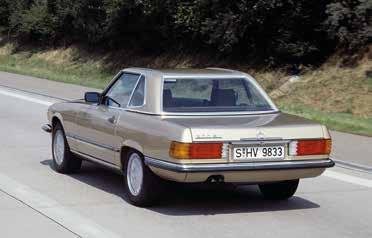
8 minute read
Mercedes-Benz SL R107
18 years production time: the Mercedes-Benz SL, R 107 series (1971-1989)
In April 1971, a new SL rolled out onto the highway, the Mercedes-Benz 350 SL. For the rst time in the history of the model series an eight-cylinder power plant under the long bonnet. From all sides it made the impression of a strong, self-con dent, imposing open-top vehicle. Its parents also gave it an equally well designed, removable coupé roof for the road. Besides elegance and quality, the body radiated safety, since the crash behaviour of the two-seater was far ahead of its time. A hard decision The decision to manufacture the R 107 series (for the rst time an SL series received the internal designation “R” as in Roadster instead of “W” as in Wagen = car) was taken by the Board of Management after intensive debates on 18 June 1968. At issue was whether there should be a Targa roof version, i.e., one with a removable roof panel, instead of the fabric-topped variant, because owing to higher safety standards alarming news was to be heard from the USA regarding the licensing of open-top cars. That a decision was nally made in favour of an open-top two-seater with a fabric roof and an additional removable hard top can be attributed to Hans Scherenberg, the head of Development, who fought tooth and nail for it: “The SL gave me great pleasure, but also caused me great trouble. This was no easy decision for us,” he summed up the decisive meeting. The history of the roadster is intimately linked to that of the coupé. For the coupé question still remained unanswered. It was not decided that day. Discussion centred around whether one
Advertisement
should additionally, and soon, make a four-seater sports coupé based on the R 107 series, or wait for the coming S-Class (W 116) to build it on that basis. But then a production model would not have arrived until much later, in the mid-1970s. Karl Wilfert, then Head of Body Design in Sindel ngen, developed – pretty much on his own authority – a coupé based on the R 107 and presented it one day to the Board of Management as a “rough draft”. Rejected at rst, Wilfert managed to push through his idea of a sports coupé with the tenacity which was so characteristic of him. And so just six months after its première the SL was followed in October 1971 by a comfortable four-seater sports coupé, the 350 SLC, whose unconventional lines also found it many friends around the world in the course of the years. Internally the series was designated C 107 (the “C” stands for “coupé”). Up to the windscreen its appearance matched that of the open-top variant; behind the windscreen the overall height and length grew. A at roof spanned the four-seater passenger compartment in a gentle curve, going over into a large and very steep rear window that arched in two directions. The boot lid was slightly convex in shape, unlike the SL’s. In the side prospect the length of the coupé is documented, rstly, by the 360-millimetre longer wheelbase (2820 millimetres versus 2460), secondly by the line of the side windows. Without interfering B-pillars they were completely retractable, as is usual in a Mercedes-Benz coupé. The SLC’s drag coe cient was better
We live and breathe classic Mercedes-Benz cars and we’ve have forged a reputation for delivering on our promises, thanks to our considerable expertise in the field and professional approach to working with clients from all over the world.



Passion drives everything we do at SLSHOP. We understand your SL isn't just a car, it's a ticket to the perfect weekend. Our team has extensive experience with classic Mercedes-Benz models from the 1950s-1990s and we are proud to be Europe's leading SL specialists. Our services include:
Health Checks Servicing & Tuning Restoration Race & Rally Preparation Performance Upgrades


than that of the SL so that the coupé attained the same performance despite an added weight of some 50 kilograms. A particularly noteworthy fact is that it fully lived up to its classi cation as a “Sports Coupé”, gaining wins for Mercedes-Benz in many rallies and long-distance races. Safety as agenda Béla Barényi’s safety concept with front and rear crumple zones and a rigid passenger cell found expression in the 107 series in a further developed form. The backbone of the R 107 is not simply a shortened and reinforced Saloon oor assembly, as in the predecessor, but an independent frame- oor unit with a closed transmission tunnel and box-shaped cross and longitudinal members which featured di ering sheet metal thicknesses and a resultant carefully de ned crumple pattern. The SL de nitely had to be an open-top car, and that being the case the only protection in a possible roll-over would be provided by the A-pillar plus windscreen. They were thoroughly redesigned and had 50 per cent more strength to show than in the previously-built version. In addition, to enhance its strength the windscreen was bonded into the frame. This resulted in a remarkable power of resistance in the roof-drop test with the result that it was possible to license the open-top car for the USA even without a Targa bar. To complete the logic the rear window of the hardtop was also bonded into its frame. In the interior there were pioneering changes to report, as well. The hard dashboard made way for an ingenious sheet-steel design that yielded on impact both in the top section and the knee area and was foam-padded. The switches and levers were recessed. The four-spoke steering wheel based on the latest ndings of accident researchers,
was also new. The proven impact absorber was still in place, but the steering-wheel rim, spokes, padded boss and hub were covered with polyurethane foam. As a further safety feature, the fuel tank was no longer installed in the rear end but above the rear axle, protected against collision. From March 1980, the anti-lock braking system ABS was o ered; from January 1982, also airbag and belt tensioner. A bestseller right o the bat But it was not the safety aspects that motivated customers around the world to quickly reach for the new SL. It was the promise of an open-top automobile that was a successful piece of engineering all round – and it was in fact the only one of its kind o ered in the USA over a period of several years. Its distinctive front end with the dominant SL face, the wide-band headlamps and grooved turn indicator covers had a powerful aura; the lines of the low silhouette were harmonious – soft top open or closed, or with hardtop. And the very slight inward curve of the boot lid, along with the concave hardtop, were reminiscent of “Pagoda” days. The wide band taillights with their ribbed surface not only were largely insensitive to soiling, but additionally gave the rear end a touch of vibrance. Extremely conducive to comfort and ease of operation was the easily and speedily operated soft top, a re ned version of the “Pagoda” top. It took just 30 seconds to open or close it. Folded, it disappeared underneath a cover that was meanwhile customary in the SL series. A number of details underscored the car’s safety aspirations. The seats were available from the start with head restraints, and seat belts also were included. Physical well-being and driver- tness safety were served by the heating system with its very spontaneous response, supported by new air ducting in the doors. Newly developed wind-de ecting mouldings on the A-pillars, which also served to channel o mud-laden water in the rain, and dirt-repelling covers on the exterior mirrors enabled good visibility. They kept the side windows clean even in inclement weather. The windscreen wipers arranged closely to each other in the centre of the car swept a respectable 70 per cent of the windscreen area, were always optimally positioned in the ow of air and did not lift o even at higher speeds. During its 18-year “production time” (which was not planned to last that long, but in the end was indeed successful), the R 107 was driven by a whole series of sixand eight-cylinder engines. Its model designations are accordingly quite varied. The eight-cylinder models were led by the 350 SL (1971 to 1980), whose 3.5-litre engine (M 116) already was known from the W 108, W 109 and W 111 series. The 147 kW (200 bhp) which it delivered at 5800 rpm helped the sports car, which weighed 1600 kilograms after all, to clock nine seconds for 0 to 100 km/h and reach a top speed of 210 km/h. The 350 SLC had identical perfor


mance gures. From autumn 1971 onwards, the 450 SL was produced, initially for the US market. At 5000 rpm its M 117 engine delivered 132 kW (180 bhp) in the California version and 140 kW (190 bhp) in the version for the other states, and from 1973 on, and 165 kW (225 bhp) in the European version. Top speed was 215 km/h: it surged from 0 to 100 km/h in 8.8 seconds. In 1972, the 450 SLC, the corresponding coupé version, followed, with identical engine and identical performance. Prior to March 1973, both were destined exclusively for export to North America, after that they were included in the general sales range. In July 1974, the SL model range was extended: the SL and SLC were now available as models 280 SL and 280 SLC with the 2.8-litre M 110 engine. It developed 136 kW (185 bhp) at 6000 rpm and had proven its reliability in the two years before in the “Stroke Eight” series W 114/115 and in the W 116-series S-Class. Both models had identical performance: the top speed was 205 km/h; they could sprint from 0 to 100 km/h in 10.1 seconds.





